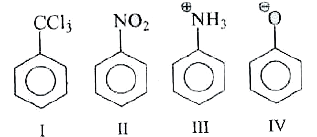In which of the following change in hybridisation is taking place ?
BF3+NH3→[H3N→BF3]
NH3+H+→NH+4
SbF5+F−→[SbF6]−
2HClO2→HClO+HClO3
The correct Answer is:A, C
To determine in which of the given options a change in hybridization is taking place, we will analyze each option step by step.
Step 1: Analyze Option A (BF3 + NH3)
1. Initial Hybridization of BF3:
- BF3 has 3 sigma bonds and no lone pairs.
- The hybridization is sp² (3 orbitals).
2. After Reaction with NH3:
- When BF3 reacts with NH3, a bond is formed between B and N.
- Now, BF3 has 4 sigma bonds (3 from BF3 and 1 from NH3).
- The new hybridization becomes sp³ (4 orbitals).
3. Change in Hybridization:
- From sp² to sp³.
Step 2: Analyze Option B (NH3 + H+)
1. Initial Hybridization of NH3:
- NH3 has 3 sigma bonds and 1 lone pair.
- The hybridization is sp³ (4 orbitals).
2. After Reaction with H+:
- NH3 forms NH4+, which has 4 sigma bonds and no lone pairs.
- The hybridization remains sp³ (4 orbitals).
3. Change in Hybridization:
- No change (remains sp³).
Step 3: Analyze Option C (SbF5 + F-)
1. Initial Hybridization of SbF5:
- SbF5 has 5 sigma bonds and no lone pairs.
- The hybridization is sp³d (5 orbitals).
2. After Reaction with F-:
- When SbF5 reacts with F-, it forms SbF6-.
- Now, SbF6- has 6 sigma bonds.
- The new hybridization becomes sp³d² (6 orbitals).
3. Change in Hybridization:
- From sp³d to sp³d².
Step 4: Analyze Option D (HClO2)
1. Initial Hybridization of HClO2:
- HClO2 has 3 sigma bonds and 1 lone pair on Cl.
- The hybridization is sp³ (4 orbitals).
2. After Reaction:
- HClO2 can form HClO and HClO3.
- The hybridization of Cl in both products remains sp³.
3. Change in Hybridization:
- No change (remains sp³).
Conclusion:
- The options where a change in hybridization occurs are:
- Option A: from sp² to sp³.
- Option C: from sp³d to sp³d².
Final Answer:
The correct options indicating a change in hybridization are A and C.
---
1. Initial Hybridization of BF3:
- BF3 has 3 sigma bonds and no lone pairs.
- The hybridization is sp² (3 orbitals).
2. After Reaction with NH3:
- When BF3 reacts with NH3, a bond is formed between B and N.
- Now, BF3 has 4 sigma bonds (3 from BF3 and 1 from NH3).
- The new hybridization becomes sp³ (4 orbitals).
- From sp² to sp³.
1. Initial Hybridization of NH3:
- NH3 has 3 sigma bonds and 1 lone pair.
- The hybridization is sp³ (4 orbitals).
- NH3 forms NH4+, which has 4 sigma bonds and no lone pairs.
- The hybridization remains sp³ (4 orbitals).
- No change (remains sp³).
1. Initial Hybridization of SbF5:
- SbF5 has 5 sigma bonds and no lone pairs.
- The hybridization is sp³d (5 orbitals).
- When SbF5 reacts with F-, it forms SbF6-.
- Now, SbF6- has 6 sigma bonds.
- The new hybridization becomes sp³d² (6 orbitals).
- From sp³d to sp³d².
1. Initial Hybridization of HClO2:
- HClO2 has 3 sigma bonds and 1 lone pair on Cl.
- The hybridization is sp³ (4 orbitals).
- HClO2 can form HClO and HClO3.
- The hybridization of Cl in both products remains sp³.
- No change (remains sp³).
- The options where a change in hybridization occurs are:
- Option A: from sp² to sp³.
- Option C: from sp³d to sp³d².
The correct options indicating a change in hybridization are A and C.
Topper's Solved these Questions
- BOOK - VMC MODULES ENGLISHCHAPTER - CHEMICAL BONDING-I & IIEXERCISE - JEE Main (Numerical Value Questions)15videos
CHEMICAL BONDING-I & II
- BOOK - VMC MODULES ENGLISHCHAPTER - CHEMICAL BONDING-I & IIEXERCISE - JEE Main (Archive)62videos
CHEMICAL BONDING-I & II
- BOOK - VMC MODULES ENGLISHCHAPTER - CHEMICAL BONDING-I & IIEXERCISE - Level - 1 (JEE Main)75videos
CHEMICAL BONDING-I & II
- BOOK - VMC MODULES ENGLISHCHAPTER - CHEMICAL BONDING & MOLECULAR STRUCTURE EXERCISE - IN-CHAPTER EXERCISE-L9videos
CHEMICAL BONDING & MOLECULAR STRUCTURE
- BOOK - VMC MODULES ENGLISHCHAPTER - CHEMICAL EQUILIBRIUMEXERCISE - IN-CHAPTER EXERCISE - G10videos
CHEMICAL EQUILIBRIUM
Similar Questions
Knowledge Check
- Question 1 - Select One
In which of the following cases nitration will take place at m-position ?
 AI onlyBII, III and IVCI, III and IVDI, II and III
AI onlyBII, III and IVCI, III and IVDI, II and III
Which of the following pairs have same hybridisation ?
View SolutionIn which of the following combination hybridisation of central atom (∗) does not change ?
View SolutionIn which of the following combination hybridisation of central atom (∗) does not change ?
View SolutionIn which of the following species, bonding is taking place in excited state ?
View SolutionIn which of the following reaction, Hybridisation of underline atom gets changed
View SolutionWhich of the following compounds have same hybridisation?
View SolutionIn which of the following hybridisation of underlined atom changes
View Solution

